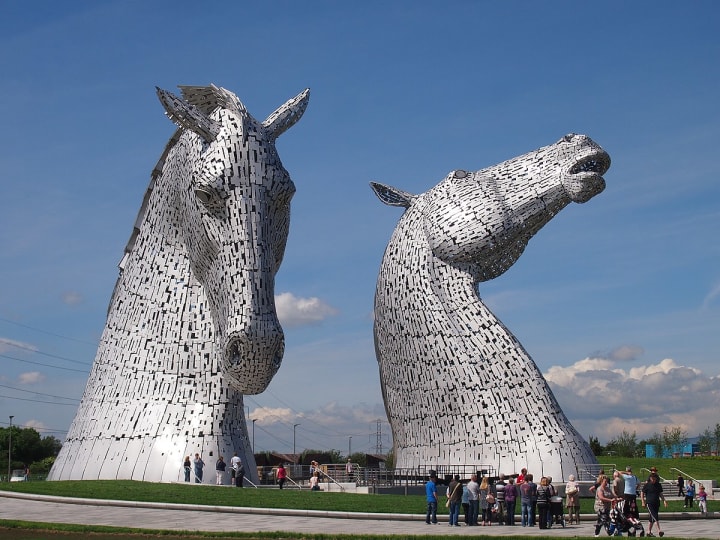The kelpie, Scotland's mythical water horse
Scotland boasts numerous legends of mythical creatures like Morag, Lochy, and Linnhe in addition to the renowned Loch Ness Monster. Equally creepy is the kelpie, a mythical water horse.

The kelpie, a monster from European mythology, is known as a legendary creature that resembles a white horse or occasionally a lovely young girl. It utilizes its guise to deceive peoples into accompanying it, only to ultimately submerge and eat them.
The kelpie is believed to be capable of elongating its body to transport multiple individuals simultaneously to the depths of the water. Its skin secretes a unique adhesive substance that causes others to become stuck upon contact. Exploiting these traits, the kelpie deceives individuals, particularly children, into making contact with it, subsequently dragging them into water
There is a story that a group of children playing suddenly heard a neigh-like sound and turned to investigate. The sound led them to the river, where they found a stunning white horse standing near the water. The children, curious by nature, approached the horse. One of them touched its smooth, sparkling body, while another climbed onto its back. After noticing an issue, they found their hands glued to the horse. Despite their efforts to free themselves, they couldn't retract their arms. As the horse headed towards the water, it pulled the children along. Ultimately, the horse dragged the children into deep water where they were devoured, except for one fortunate boy who managed to escape by severing his hand.

Kelpies are known for their magical abilities, such as summoning floods to carry people away. The noise of their tails dipping into the water is likened to thunder. Should you hear a troubling cry or howl while near a river, beware - it might be a kelpie cautioning you.
It can change into a white horse and a human, identifiable by weeds in its hair. Legend speaks of a Kelpie taking the form of a woman to lure men to streams, overpowering them and consuming them. It may also transform into a young or old man to entice others.
Scottish folklore features various versions of the Kelpie, with the Barra folk tale being the most well-known. This particular story revolves around a solitary Kelpie who assumes the form of a young man in order to wed a lovely maiden. However, the maiden discerns its true identity due to the presence of weeds in its hair. After removing the boy's necklace, known as the Kelpie's Bridle, the creature reverts back to its original Kelpie form. The maiden then brings the Kelpie to her farm, where it labors for a year.
The girl sought advice from a wise man who advised her to give the necklace back to Kelpie. The wise man inquired if he could revisit his initial encounter with the girl. Would he opt to devour the girl or proceed with marrying her? He decided to wed the girl. Subsequently, he questioned the girl whether she would choose to be his wife if he was a man. Her She answered yes.

Like the Werewolves in movies, kelpies can also be destroyed by silver objects such as arrows or silver bullets.
Furthermore, it can be tamed with a cross-shaped object when manifesting as a horse. Its power was harnessed by ancient people for moving large stones. Legend has it that the landowner Morphie enlisted its help for labor. However, the creature grew upset by Morphie's deceit and supposedly placed a curse upon completion of the task. Subsequently, the fortune of the Morphie family dwindled.
Many regions in Scotland near bodies of water feature their own version of the Kelpie legend. Some tales even suggest that the Loch Ness monster could be a Kelpie. The belief in deities is thought to have given rise to this myth, as people sought to satisfy the gods through offerings. Moreover, the story serves as a cautionary tale, advising youngsters to steer clear of perilous rivers and lakes, and warning women and children to be cautious around unfamiliar individuals.
Kelpie legends had an impact on artistic creations, such as Thomas Millie Dow's 1895 sketch of a sorrowful black-haired young woman and Draper's 1913 oil painting.

Two steel sculptures, each standing at a height of 30 meters (98 feet), are located in Falkirk along the Forth and Clyde canal. Known as The Kelpies, these sculptures were designed by artist Andy Scott to honor Scotland's horse industry. The construction of The Kelpies finished in October 2013, and they were unveiled for public viewing in April 2014.







Comments (1)
This is a wonderful piece of work, but I wouldn't want to find a Kelpie after reading it!